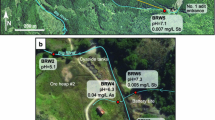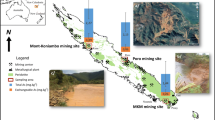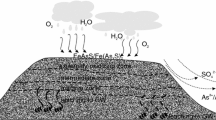Abstract
Hydrochemical data are presented for arsenic (As) in the mine waters of 34 gold and base-metal mining localities in seven countries of south-east Asia, Africa and Latin America, encompassing contrasting climatic settings and at least eight discrete styles of primary mineralization. Peak dissolved As concentrations at these sites range from 0.005–72 mg/l, with the United States Environmental Protection Agency (US-EPA) potable water threshold of 50 μg/l exceeded in 25 cases. Arsenate (As5+) constitutes the dominant species at over 80% of sites. Very high dissolved As concentrations (>1 mg/l) show no systematic between-site relationship with mine water pH/Eh regime. Important determinants of mine water As fluxes include iron hydrochemistry, the presence of cyanic ore processing effluents, site geology, the paragenetic sequence that follows sulphide oxidation, climate and mine management. Human toxicological impacts of As contamination have been recognized at only one case-study site, with a further four considered to warrant more detailed risk assessment.
Similar content being viewed by others
Author information
Authors and Affiliations
Additional information
Received: 2 November 1999 · Accepted: 21 March 2000
Rights and permissions
About this article
Cite this article
Williams, M. Arsenic in mine waters: an international study. Environmental Geology 40, 267–278 (2001). https://doi.org/10.1007/s002540000162
Issue Date:
DOI: https://doi.org/10.1007/s002540000162




